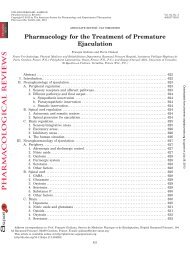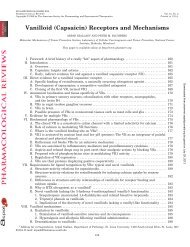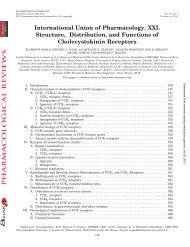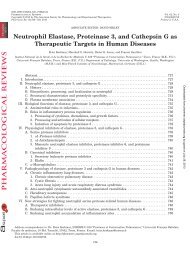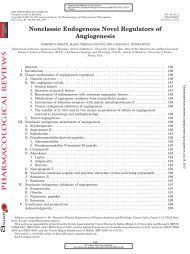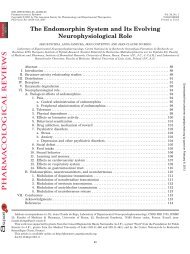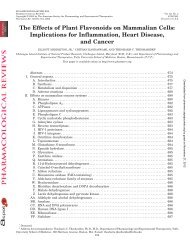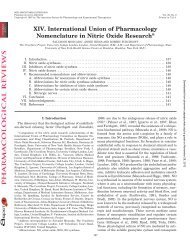Opioids, Reward and Addiction: An Encounter of Biology ...
Opioids, Reward and Addiction: An Encounter of Biology ...
Opioids, Reward and Addiction: An Encounter of Biology ...
Create successful ePaper yourself
Turn your PDF publications into a flip-book with our unique Google optimized e-Paper software.
In conclusion, although there seems some evidence <strong>of</strong><br />
a role <strong>of</strong> brain DA in opioid dependence, as revealed from<br />
animal experiments, the precise role is not yet elucidated.<br />
Studies using the self-administration paradigm,<br />
measuring the positive reinforcing effects <strong>of</strong> opioids<br />
among others, do not suggest a critical role for NAC DA<br />
for opioid reinforcement. The limited studies on the interaction<br />
between DA <strong>and</strong> opioids in the ICSS procedure<br />
do not allow definitive conclusion to be drawn. Data from<br />
conditioned place preference studies reveal a critical role<br />
<strong>of</strong> NAC DA receptors in conditioned place preference <strong>and</strong><br />
aversion induced by opioid agonists <strong>and</strong> antagonists.<br />
The place preference method involves classical conditioning<br />
rather than operant conditioning as involved in<br />
self-administration <strong>and</strong> ICSS. In addition, although selfadministration<br />
<strong>and</strong> ICCS provide measures <strong>of</strong> reinforcement,<br />
data gathered using place preference are hard to<br />
interpret but most likely represent some motivational<br />
effects <strong>of</strong> the drugs used. Thus, DA mechanisms may be<br />
more involved in the distinct conditioning <strong>and</strong> certain<br />
motivational processes concerned in opioid dependence<br />
than in opioid reinforcement (Robinson <strong>and</strong> Berridge,<br />
1993; Wolterink et al., 1993; Kiyatkin, 1995; Robbins<br />
<strong>and</strong> Everitt, 1996; Salamone, 1996; Nader et al., 1997;<br />
Schultz et al., 1997). Accordingly, the unconditioned reinforcing<br />
properties <strong>of</strong> food <strong>and</strong> sexual stimuli appeared<br />
to be intact after accumbens DA depletion <strong>and</strong> the functions<br />
<strong>of</strong> accumbens DA may be related to the behavioral<br />
responsiveness to conditioned stimuli <strong>and</strong> to the organization<br />
<strong>of</strong> goal-directed behaviors (Kiyatkin, 1995;<br />
Salamone, 1996; Nader et al., 1997). In conclusion, more<br />
studies are needed to elucidate the significance <strong>of</strong> brain<br />
DA systems in the dynamics <strong>of</strong> opioid dependence, in<br />
particular since neuroleptics are not the drugs <strong>of</strong> choice<br />
to treat human opioid addicts (Practice Guideline American<br />
Psychiatric Association, 1995).<br />
VIII. <strong>Addiction</strong> <strong>and</strong> Endogenous <strong>Opioids</strong><br />
In this section the role <strong>of</strong> brain opioids in dependence<br />
on opiates <strong>and</strong> on other drugs will be discussed. In<br />
clinical practice the term opiate addiction is normally<br />
used, <strong>and</strong> especially heroin, morphine, <strong>and</strong> opium are<br />
consumed by addicts. In trying to discuss the significance<br />
<strong>of</strong> the experimental data <strong>and</strong> psychological concepts<br />
as described before for drug dependence (see I.<br />
<strong>Addiction</strong>), it is worthwhile to delineate four stages in<br />
the addiction course: the initiation phase, maintenance<br />
phase, withdrawal phase, <strong>and</strong> relapse phase. Different<br />
psychological <strong>and</strong> biological mechanisms seem to be important<br />
for the drug use in these stages.<br />
The first contact between an individual <strong>and</strong> an opiate<br />
is usually in the context <strong>of</strong> a medicinal treatment <strong>of</strong> an<br />
illness, e.g., severe pain, or by the desire to experience<br />
the effect <strong>of</strong> the drug. As mentioned before, medicinal<br />
treatment with opiates will evoke the addiction habit in<br />
a very small percentage <strong>of</strong> the individuals only <strong>and</strong> is<br />
not an issue <strong>of</strong> major concern. The desire to experience<br />
OPIOIDS, REWARD AND ADDICTION 381<br />
the effect <strong>of</strong> the drug is usually stimulated by the environment<br />
<strong>of</strong> the individual, either because the person is<br />
informed about the marvelous effects or in his or her<br />
setting the drug is used. Whether or not the opiate use<br />
will be continued depends among others on the subjective<br />
effects <strong>of</strong> the drug—whether the drug is liked—<br />
<strong>and</strong>/or the expectation that this positive subjective effect<br />
will be (re-)experienced on repeated use. The positive<br />
subjective effects may include euphoria (feeling <strong>of</strong> well<br />
being) <strong>and</strong> even ecstasy, which exceed the possible negative<br />
effects. The subjective experience with the first use<br />
<strong>of</strong> the drug may also be influenced by whether or not the<br />
person has used other drugs before or is addicted to<br />
other drugs. In particular, addicts are quite sensitive to<br />
the subjective effects <strong>of</strong> drugs <strong>and</strong> can discriminate well<br />
between the effects <strong>of</strong> various drugs. Regular use can<br />
result in psychic dependence, characterized by more or<br />
less compulsive drug use.<br />
It is quite obvious that not all individuals who experienced<br />
the drug <strong>and</strong> even regularly used the drug will<br />
reach the stage <strong>of</strong> psychic dependence. In fact, a vast<br />
majority <strong>of</strong> people that at some time experiences the<br />
drug will not develop an addiction. Thus, the question<br />
emerges why some individuals are more susceptible to<br />
develop psychic dependence than others. Although social<br />
factors <strong>and</strong> context may be important in this respect, the<br />
drug-induced neuroadaptation underlying psychic dependence<br />
may play an important role in the individual<br />
susceptibility to develop psychic dependence. During the<br />
initiation phase <strong>of</strong> opiate addiction, the positive reinforcing<br />
effects <strong>of</strong> the drug <strong>and</strong> the vulnerability <strong>of</strong> the individual<br />
for the development <strong>of</strong> the dependence are important<br />
issues. The positive subjective effects like euphoria<br />
have been linked to the reinforcing or rewarding effect <strong>of</strong><br />
the drug <strong>and</strong> may be important why the drug is liked,<br />
although convincing evidence for this statement is not<br />
available. Whether physical dependence may already<br />
play a role in the initiation phase <strong>of</strong> opiate addiction is<br />
not known. Experimental animal data however indicate<br />
that physical dependence hardly contributes to the development<br />
<strong>of</strong> opioid self-administration (Woods <strong>and</strong><br />
Schuster, 1971; Van Ree et al., 1978; Dai et al., 1989).<br />
The process <strong>of</strong> initiation <strong>of</strong> addiction to other than opiate<br />
drugs is quite similar as described for opiates, but the<br />
duration <strong>of</strong> this phase varies among drugs (e.g., compare<br />
heroin <strong>and</strong> alcohol).<br />
<strong>Opioids</strong> are reinforcing <strong>and</strong> enhance ICSS. These actions<br />
are mediated by receptors, at least for an important<br />
part (see III. Self-Administration <strong>and</strong> IV. Intracranial<br />
Electrical Self-Stimulation). The brain site <strong>of</strong> the<br />
reinforcing action <strong>of</strong> opioids is still a matter <strong>of</strong> debate,<br />
although the VTA is a sensitive site in this respect. The<br />
suggestion however that the mesolimbic dopaminergic<br />
system, in particular the ventral tegmental-accumbal<br />
pathway, is the site <strong>of</strong> action, has not been substantiated<br />
by experimental data. It is also not clear whether one<br />
particular site or various sites within one circuit or



